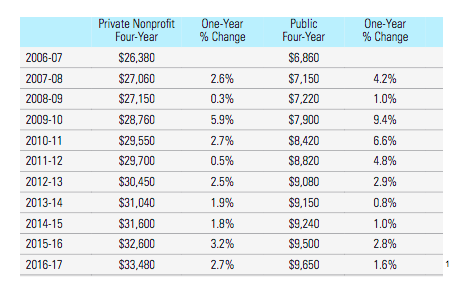
Five Steps to an A+ College Plan
By Preston Rosamond
Regardless of whether your child is two or twelve, the thought of college has probably crossed your mind. In the busyness of life and never-ending financial pressures, it is all too easy to put saving for college on the back burner. But one thing in life is certain; it moves quickly. Don’t get caught unaware and unprepared for college. Your child’s education is one of the most important investments you can make, and with today’s costs, it pays to plan ahead.
As we just celebrated National 529 College Savings Plan Awareness Day, ask yourself this question: Have you started saving for your child’s future education costs? If you haven’t, it’s time to consider these five steps.
Step 1: Know the Cost of College
College tuition gets more expensive every year, and the numbers can cause anyone to break out in a sweat. Tuition rates have increased at a faster pace than many other items over the past decade and it doesn’t look like they will slow down anytime soon. Over the past ten years, college costs have risen an average of 2.4% a year for private schools and 3.5% for public colleges.

If this upward trend continues, in 25 years it could cost $300,000 to obtain a four-year undergraduate degree. The costs will vary depending on the institution attended, room and board, and other educational expenses, but either way, that’s a pretty penny for four years of school. For a 2017 graduate, the average student loan balance was over $37,000 (2) and the average monthly student loan payment is $351. (3) For students just beginning their careers, that’s a hefty bill to pay. The substantial cost may seem overwhelming but knowing what to expect gives you a goal to aim for.
Step 2: Start Saving
It’s never too late or too early to start saving for your child’s college fund. By starting early, you can reap the rewards of compound interest. (4) If you wait, your account balance may not be as high, but you are still investing something into your child’s future.
Even if you don’t think you have enough room in your budget to add another line item, $25 a month is still $25 more than $0. Setting up automatic contributions is a good way to remind yourself that college is getting closer and your monthly account statement will keep this goal in the forefront of your mind.
Step 3: Decide How You’ll Save for College
The most common method people use to save for college is through a 529 plan. A 529 plan is a state-sponsored education savings account that allows earnings to grow on a tax-deferred status. There are two categories of 529 plans: prepaid tuition plans and college savings plans.
Prepaid plans let you pay future tuition costs at today’s prices, which, considering skyrocketing college costs, can be enticing. On the other hand, college savings plans have no age or income restrictions and allow you save up to $300,000 per child in many state programs and then use it, tax-free, for qualified education expenses. As an added benefit, you are not limited to using the plan offered by the state you live in. Some states give you a tax credit for using their plan, but in many cases, it’s worth it to shop around.
Beyond 529 plans, some families use Roth IRAs. Your Roth contributions can be withdrawn at any time and can be used for any purpose. In addition, Roth IRAs can help you avoid the high fees that some 529 plans charge and they also offer virtually unlimited investment options. IRAs will not have any impact on your financial aid eligibility.
For college savings, Roth IRAs aren’t the perfect option, but they do offer an alternative to the traditional 529 plans. Think about opening a 529 plan for college, but also continuing to contribute to a Roth for retirement. This strategy gives you extra resources to draw on if you need them.
Step 4: Break the Cost of College into Thirds
While some people are able to save and pay for the total cost of their child’s college education, most people don’t fit into this category. Instead of letting that fact get you down, break the cost of college into thirds.
The first part is to save before your children head off to college. By starting early and having some help from the markets, you can accumulate a solid base to use for tuition as well as room and board. The next step is to plan on paying for about one-third of the costs while your child is in college. This can be through a combination of scholarships, grants, a part-time job for your child or contributions from the family.
The final piece is student loans that your child or you can repay after they have completed their education. Since the goal is to minimize student loans, try to maximize the first two parts of this three-pronged strategy first.
Step 5: Be Proactive
Just like your 401(k) plan, you need to monitor your college planning investments. While in the early days of saving for college you will want to be more aggressive with your investments. As college draws closer, the investment allocation should become more conservative, just like a retirement account. It is also helpful to monitor your balances, keep an eye on the changing college costs, and track your progress towards your goal.
If you think a 529 plan might be a good idea for you and your family, we can help. We can explain all your 529 plan options and help you decide which is best for your individual college planning needs. If you already have a 529 plan set up, it is important that you have an experienced professional managing the investments in your account.
Let us help you prepare for the future. With our guidance, you can start saving for your child’s future today so you can ease the worries of tomorrow. To get started, call my office at 830-798-9400 or email smrosamond@rosamondfinancialgroup.com.
About Preston
Preston Rosamond is a financial advisor and the founder of The Rosamond Financial Group with nearly two decades of industry experience. He provides comprehensive wealth management and financial services to individuals, professionals, and families who enjoy simplicity and seek a professional to help them pursue their goals. Preston personally serves his clients with an individual touch and a sincere heart, and his servant’s attitude is evident from the moment you meet him. Learn more about Preston or start the conversation about your finances with him by emailing smrosamond@rosamondfinancialgroup.com.
________
(1) https://trends.collegeboard.org/sites/default/files/2016-trends-college-pricing-web_0.pdf
(3) https://studentloanhero.com/wp-content/uploads/Student-Loan-Hero-2017-Student-Loan-Statistics.pdf
(4) http://www.businessinsider.com/amazing-power-of-compound-interest-2014-7
* The opinions contained in this material are those of the author, and not a recommendation or solicitation to buy or sell investment products. This information is from sources believed to be reliable, but Summit cannot guarantee or represent that it is accurate or complete.

